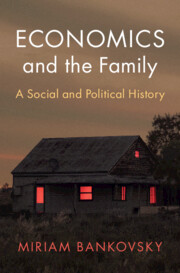Refine search
Actions for selected content:
179 results
Estimating the growth effect of the demographic dividend
-
- Journal:
- Macroeconomic Dynamics / Volume 29 / 2025
- Published online by Cambridge University Press:
- 08 August 2025, e127
-
- Article
-
- You have access
- Open access
- HTML
- Export citation
Harnessing the Metaverse for corporate training: Identifying critical competencies through SF-BBWM and GINA
-
- Journal:
- Journal of Management & Organization / Volume 31 / Issue 5 / September 2025
- Published online by Cambridge University Press:
- 31 July 2025, pp. 2572-2589
-
- Article
-
- You have access
- Open access
- HTML
- Export citation
7 - Fictions for a Future: ‘The Families We Choose’ in a Context of Ecosystem Collapse
-
- Book:
- Economics and the Family
- Published online:
- 08 May 2025
- Print publication:
- 05 June 2025, pp 260-270
-
- Chapter
- Export citation
5 - A Post-War ‘Underclass’ in Affluent North America: Black Family Instability, Human Capital Theory, and Gary Becker’s New Household Economics
-
- Book:
- Economics and the Family
- Published online:
- 08 May 2025
- Print publication:
- 05 June 2025, pp 174-219
-
- Chapter
- Export citation
Migration, child education, human capital accumulation, and a brain dilution tax
-
- Journal:
- Journal of Demographic Economics , First View
- Published online by Cambridge University Press:
- 27 May 2025, pp. 1-18
-
- Article
- Export citation
Heterogeneous effects of economic freedom on human capital in developing countries
-
- Journal:
- Journal of Institutional Economics / Volume 21 / 2025
- Published online by Cambridge University Press:
- 16 May 2025, e18
-
- Article
-
- You have access
- Open access
- HTML
- Export citation
Wealth, search, and human capital over the business cycle
-
- Journal:
- Macroeconomic Dynamics / Volume 29 / 2025
- Published online by Cambridge University Press:
- 15 May 2025, e99
-
- Article
-
- You have access
- Open access
- HTML
- Export citation

Economics and the Family
- A Social and Political History
-
- Published online:
- 08 May 2025
- Print publication:
- 05 June 2025
Introduction
-
- Book:
- Cultural Learning in Urban Schools and Minority Serving Institutions
- Published online:
- 20 March 2025
- Print publication:
- 03 April 2025, pp 1-8
-
- Chapter
- Export citation
Climate shocks and human capital:evidence from Uganda
-
- Journal:
- Environment and Development Economics , First View
- Published online by Cambridge University Press:
- 24 March 2025, pp. 1-21
-
- Article
-
- You have access
- Open access
- HTML
- Export citation
Health effects on children's willingness to compete
-
- Journal:
- Experimental Economics / Volume 15 / Issue 1 / March 2012
- Published online by Cambridge University Press:
- 14 March 2025, pp. 58-70
-
- Article
- Export citation
6 - Colonial Development in a Comparative Perspective
-
- Book:
- An Economic History of India
- Published online:
- 06 February 2025
- Print publication:
- 13 February 2025, pp 161-186
-
- Chapter
- Export citation
Gender differences in the gap between desired and observed fertility in Spain
-
- Journal:
- Journal of Demographic Economics , First View
- Published online by Cambridge University Press:
- 04 February 2025, pp. 1-19
-
- Article
- Export citation
Human capital of the US deaf population from 1850 to 1910
-
- Journal:
- Social Science History / Volume 49 / Issue 1 / Spring 2025
- Published online by Cambridge University Press:
- 02 April 2025, pp. 104-138
- Print publication:
- Spring 2025
-
- Article
- Export citation
7 - Health, Human Capital, and Its Contribution to Economic Growth
-
-
- Book:
- The Cambridge Handbook of Healthcare
- Published online:
- 21 November 2024
- Print publication:
- 28 November 2024, pp 185-216
-
- Chapter
- Export citation
8 - Economic Implications of Diversity in West Germany
- from Part IV - Long-Run Economic Consequences of Uprooting
-
- Book:
- Uprooted
- Published online:
- 07 November 2024
- Print publication:
- 21 November 2024, pp 200-227
-
- Chapter
- Export citation
7 - Economic Implications of Diversity in Poland
- from Part IV - Long-Run Economic Consequences of Uprooting
-
- Book:
- Uprooted
- Published online:
- 07 November 2024
- Print publication:
- 21 November 2024, pp 173-199
-
- Chapter
- Export citation
The effect of the social security on aggregate effective labor supply: the role of endogenous human capital and of selection effects
-
- Journal:
- Macroeconomic Dynamics / Volume 29 / 2025
- Published online by Cambridge University Press:
- 14 October 2024, e44
-
- Article
- Export citation
A model of endogenous education quality: the role of teachers
-
- Journal:
- Macroeconomic Dynamics / Volume 29 / 2025
- Published online by Cambridge University Press:
- 23 September 2024, e33
-
- Article
- Export citation
Not a good fit? The roles of aesthetic labour, gender, race, Indigeneity, and citizenship in food service employment
-
- Journal:
- The Economic and Labour Relations Review / Volume 35 / Issue 3 / September 2024
- Published online by Cambridge University Press:
- 02 September 2024, pp. 664-684
-
- Article
-
- You have access
- Open access
- HTML
- Export citation


